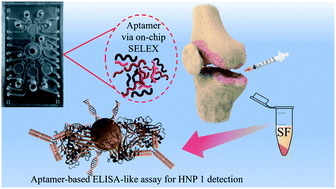Aptamer selection against alpha-defensin human neutrophil peptide 1 on an integrated microfluidic system for diagnosis of periprosthetic joint infections†‡
Abstract
Periprosthetic joint infections (PJIs) arising from joint arthroplasty are dreadful, yet difficult to diagnose in subtle cases. Definite diagnosis requires microbiological culture to confirm the causative pathogens. However, up to 40% of culture-negative PJI needs other surrogate biomarkers such as human neutrophil peptide 1 (HNP 1) to improve diagnostic accuracy or gauge therapeutic responses. To devise a diagnostic method, systematic evolution of ligands by exponential enrichment (SELEX) (five rounds) was used to screen PJI biomarkers on a compact (20 × 20 × 35 cm), integrated microfluidic system equipped with two separate Peltier devices and one magnetic control module where an aptamer with high affinity and specificity for HNP 1, which has been used as one of the synovial fluid (SF) biomarkers for detecting PJI, was identified for the first time. Two rounds of negative selection (with immunoglobulin G & human serum album) on-chip followed by one round of unique “competitive selection” with SF extracted from PJI patients validated the specificity of the HNP 1 aptamer. The dissociation constant was measured to be 19 nM. The applicability of SF HNP 1 levels for diagnosing PJI was then verified by a new aptamer-based enzyme-linked immunosorbent assay (ELISA)-like assay. It is envisioned that this new aptamer and the associated assay could be used in future clinical applications.

- This article is part of the themed collections: Miniaturised Sensors & Diagnostics and Lab on a Chip HOT Articles 2021


 Please wait while we load your content...
Please wait while we load your content...